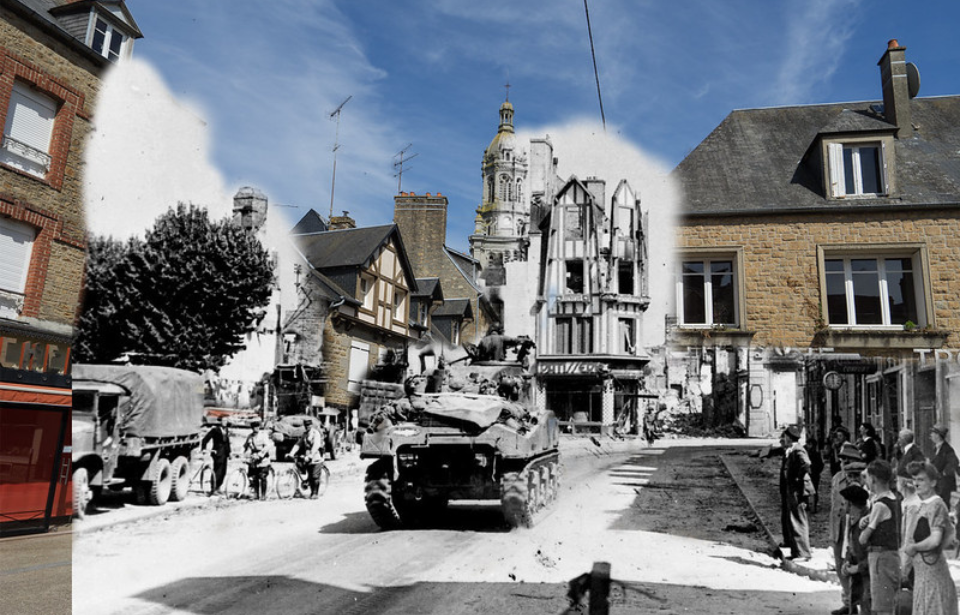There’s nothing that better showcases the true impact of the Second World War than photos of the locations where the fighting took place. While it might be hard to picture the scenes with images captured in modern times, a photographer by the name of Falcon® Photography on Flickr found an ingenious way to meld then and now photos of France during WWII, bringing to life what life was like throughout the conflict.
83rd Infantry Division

Then and Now – 1944/2017: The 83rd Infantry Division first saw action during WWII in 1944. It’s members participated in the D-Day landings, arriving on Omaha Beach and moving inland. The division saw action in the Battle of Saint-Malo, and by September 25, 1944 had taken Luxembourg.
Following their advance to the Siegfried Line, the 83rd participated in the Battle of Hürtgen Forest and the Battle of the Bulge, before moving across the Rhine as part of Operation Grenade and capturing Neuss. In April 1945, they came upon Langenstein-Zwieberge, a subcamp of Buchenwald, and liberated it alongside the US 8th Armored Division.
Germans in Le Havre

Then and Now – 1942/2018: The German occupation of Le Havre began in 1940 and stayed in place until the Allies launched Operation Astonia. The city was of the utmost importance to the enemy, who set up a naval base in preparation of the planned invasion of the United Kingdom, dubbed Operation Sea Lion. The mission never occurred, with troops being sent to the Eastern Front for Operation Barbarossa, the invasion of the Soviet Union.
Le Havre was bombed 132 times by the Allies throughout the course of the Second World War, with the worst air raids occurring in the days before Operation Astonia, which eventually led to the city’s liberation. Overall civilian casualties during the conflict were in the tens of thousands, and countless buildings and farmers’ fields were destroyed.
Liberation of Renees

Then and Now – 1944/2017: Rennes fell to the Germans shortly after the Battle of France and remained under their control until August 1944. Throughout the course of the Battle of Normandy, the city was subject to a number of Allied air raids, which caused severe damage.
Following the liberation of Avranches, Rennes became encircled by American troops and members of the French Forces of the Interior (FFI), prompting Gen. Paul Hausser of the German 7th Army to order an evacuation.
German prisoners at Juno Beach

Then and Now – 1944/2017: The largest amphibious landing to occur in WWII, the Allied efforts on D-Day resulted in a number of German casualties: 23,000 dead and 67,000 wounded at Normandy.
The Germans were slow to surrender, meaning the number taken as prisoners of war (POWs) following D-Day increased as the Allied forces moved inland. It’s reported that on June 9, 1944, 4,000 POWs had been taken, a number that steadily increased to 200,000 upon the conclusion of the Normandy Campaign.
Sinking of the HMS Fury
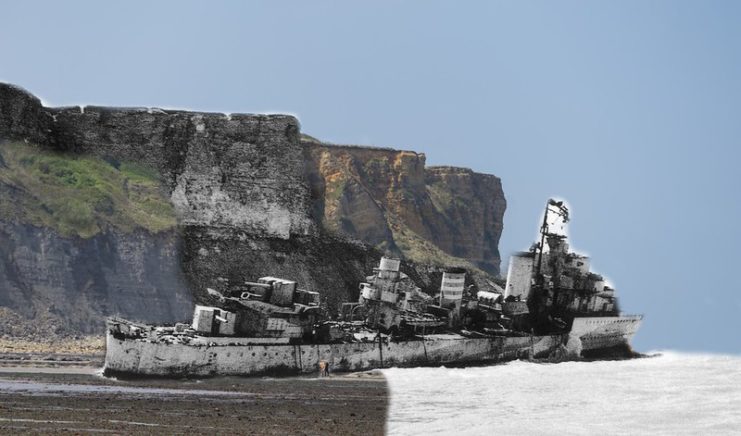
Then and Now – 1944/2017: On June 21, 1944, the HMS Fury (H76), an F-class destroyer built for the Royal Navy, struck a mine off Juno Beach. The decision was made to tow her to one of Britain’s temporary harbors at Arromanches-les-Bains. During the journey, she struck a number of ships, including a freighter and ammunition vessel, before being driven ashore.
After being refloated and returned to the UK, Fury was declared a constructive total loss and scrapped.
82nd Airborne Division in France

Then and Now – 1944/2017: The 82nd Airborne Division took part in pretty much every major offensive in the European Theater during WWII. Redesignated just two months after the Japanese attack on Pearl Harbor, the paratroopers saw action during Operation Husky and on Utah Beach during the D-Day landings.
As the war progressed, the 82nd merged with others to become the First Allied Airborne Army, upon the order of Gen. Dwight D. Eisenhower. Under this designation, they were dropped into the Netherlands as part of Operation Market Garden, after which they faced the German during the Battle of Elsenborn Ridge, the northernmost engagement of the Battle of the Bulge. They then entered Germany, where they remained following the country’s surrender.
Carentan Great War Memorial
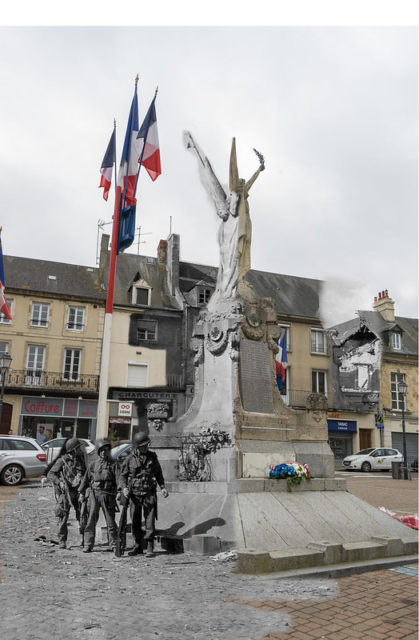
Then and Now – 1944/2017: The Carentan Great War Memorial was erected in remembrance of those who fought and lost their lives during the First World War. After the end of WWII, a plaque was added to honor the victims of the conflict.
The Battle of Carentan was an engagement between the airborne divisions of the US and German armies, as part of Operation Overlord. Fought between June 10-14, 1944, it saw the 101st Airborne Division pushback the German forces, who were low on ammunition, after which the 2nd Armored Division successfully fought back against a counterattack.
The defensive capabilities of the Atlantic Wall

Then and Now – 1944/2017: The Azeville Battery was part of the German Army’s intimidating Atlantic Wall during WWII. A coastal defensive fortification that spanned the coastal regions of German-occupied Europe and Scandinavia, it took two years to complete. The Azeville Battery, in particular, was manned by a garrison of 170 servicemen who were commanded by Capt. Hugo Treiber.
On June 7, 1944, the US 4th Infantry Division found themselves blocked along the casemates that made up the Azeville Battery. While assaults were launched the next day by the 22nd Infantry Regiment, they failed to stop the Germans from opening fire on the neighboring position of Crisbecq Battery, on the orders of Oberleutnant zur Zee Walter Ohmsen of the Kriegsmarine.
German occupation of Mont-Saint-Michel

Then and Now – 1944/2017: The German Army occupied Mont-Saint-Michel throughout WWII, beginning in June 1940. The location served as both a lookout post and a popular tourist attraction, with an estimated 325,000 tourists visiting the commune between July 1940 and the end of the enemy occupation.
Following the D-Day landings, hundreds upon hundreds of German soldiers retreated to locations like Mont-Saint-Michel. On August 1, 1944, Allied forces entered the commune, much to the relief of locals. In a rare occurrence, it was liberated without a single shot being fired.
Raising the American flag
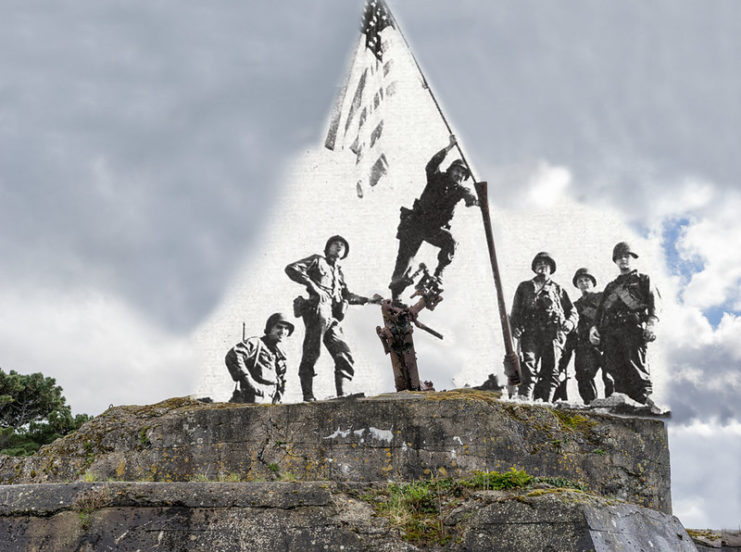
Then and Now – 1944/2018: Used as a bunker by German soldiers during their occupation of France, La Cite d’Aleth in Saint-Malo and its Bofors 40 mm gun were taken out by an explosive. Following this, US soldiers planted the American flag on the site, solidifying this particular victory against the Axis Powers.
Going over the seawall
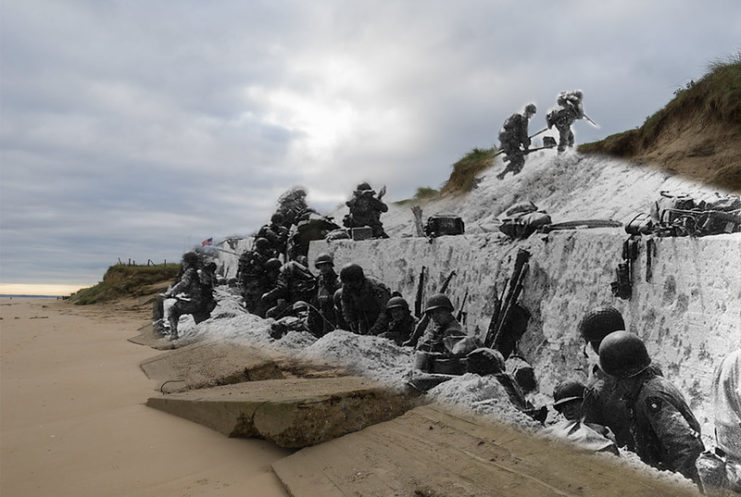
Then and Now – 1944/2017: After landing on Utah Beach, the 8th Infantry Regiment, 4th Infantry Division climbed over the seawall to move further inland. They were able to make it up the beach as a result of the de-mining efforts of the 237th and 299th Combat Engineer Battalions.
Through the use of explosives and dozers, the 237th and 299th cleared away the hazardous beach obstacles that lay between the water and the seawall, allowing for the move inland by the American forces.
Captured German Naval Signals Command bunker
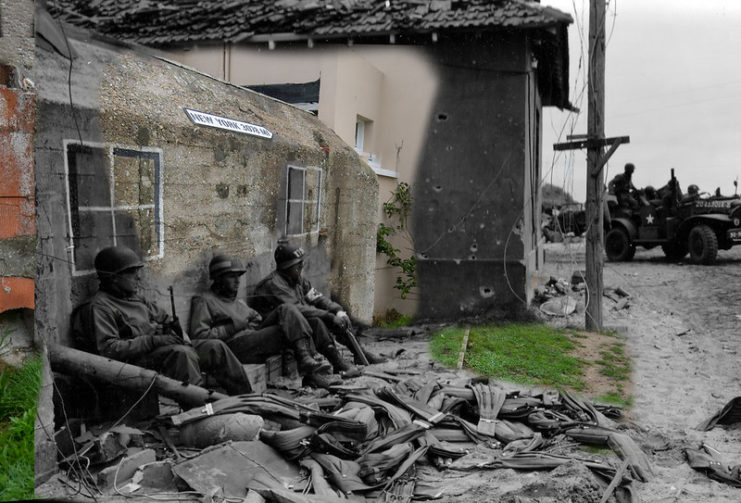
Then and Now – 1944/2017: As the Allied forces pushed their way into France following D-Day, they captured a number of German-held positions, including bunkers manned by the Naval Signals Command. While its headquarters was located on Guernsey, in the English Channel, a number of outposts were in strategic areas.
Operation Cobra pushes the Germans out of Saint-Lô
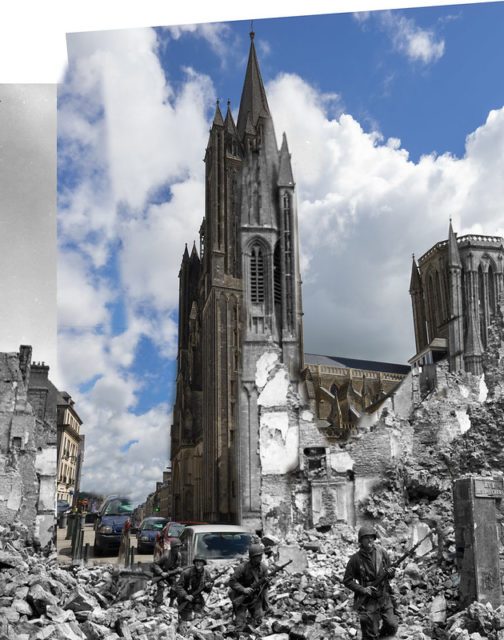
Then and Now – 1944/2017: The Battle of Normandy was among the largest offensives of WWII, and part of it was Operation Cobra. It was preceded by the Battle of Saint-Lô, which saw 95 percent of the city lost to American air raids aimed at pushing out the German occupiers. The level of destruction and the amount of casualties leant themselves to Saint-Lô being dubbed a “martyr city” and “The Capital of Ruins.”
Operation Cobra began following the victory at Saint-Lô and is considered the mission that allowed the Allies to break out of Normandy and secure France’s liberation. Launched by Lt. Gen. Omar Bradley‘s US First Army, it consisted of assaults on German positions. Among the cities liberated during this time was Coutances, thanks to the efforts of the 4th Armored Division.
Memorial Régiment de la Chaudière of Canada

Then and Now – 1944/2017: The Régiment de la Chaudière of Canada was mobilized on September 1, 1939, the day of the German invasion of Poland. Its members participated in the D-Day landings on June 6, 1944, arriving on Juno Beach. The total Canadian casualties to occur on that day totaled 1,200, and there’s since been a memorial erected for those who perished.
Easy Company in France

Then and Now – 1944/2017: One of the most prolific military units in all of WWII, Easy Company, 2nd Battalion, 506th Parachute Infantry Regiment, 101st Airborne Division participated in a number of major offensives. Their actions were depicted in the HBO miniseries, Band of Brothers (2001), which was executively produced by Tom Hanks and Steven Spielberg.
More from us: 22 Images That Show the Many Faces of World War II
Easy Company parachuted into Normandy on D-Day, after which they made their way through Europe, participating in Operation Market Garden in the Netherlands and facing the Germans during the bloody Battle of the Bulge. It was during the latter that their defining moment came: the Siege of Bastogne.
Shortly after the war came to an end, Easy Company and the whole of the 506th were disbanded. Of those who served with the company, 49 were killed in action (KIA).
